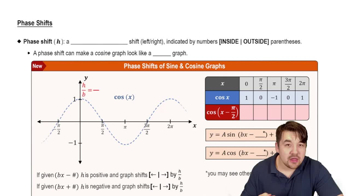Here are the essential concepts you must grasp in order to answer the question correctly.
Cosine Function
The cosine function is a fundamental trigonometric function that describes the relationship between the angle and the adjacent side over the hypotenuse in a right triangle. It is periodic, with a standard period of 2π, meaning it repeats its values every 2π radians. The graph of the cosine function is a wave that oscillates between -1 and 1, and it is symmetric about the y-axis.
Recommended video:
Graph of Sine and Cosine Function
Vertical Shift
A vertical shift in a function occurs when a constant is added or subtracted from the function's output. In the given function, y = 2 cos(1/3 x) - 2, the '-2' indicates a downward shift of the entire cosine graph by 2 units. This transformation affects the midline of the graph, moving it from y=0 to y=-2, while the amplitude and period remain unchanged.
Recommended video:
Amplitude and Period
The amplitude of a trigonometric function refers to the height of the wave from its midline to its maximum or minimum value. In the function y = 2 cos(1/3 x) - 2, the amplitude is 2, indicating the graph will reach a maximum of -2 + 2 = 0 and a minimum of -2 - 2 = -4. The period, determined by the coefficient of x, is calculated as 2π divided by the coefficient, resulting in a period of 6π for this function.
Recommended video:
Period of Sine and Cosine Functions
 Blitzer 3rd Edition
Blitzer 3rd Edition Ch. 2 - Graphs of the Trigonometric Functions; Inverse Trigonometric Functions
Ch. 2 - Graphs of the Trigonometric Functions; Inverse Trigonometric Functions Problem 13
Problem 13 Verified step by step guidance
Verified step by step guidance


